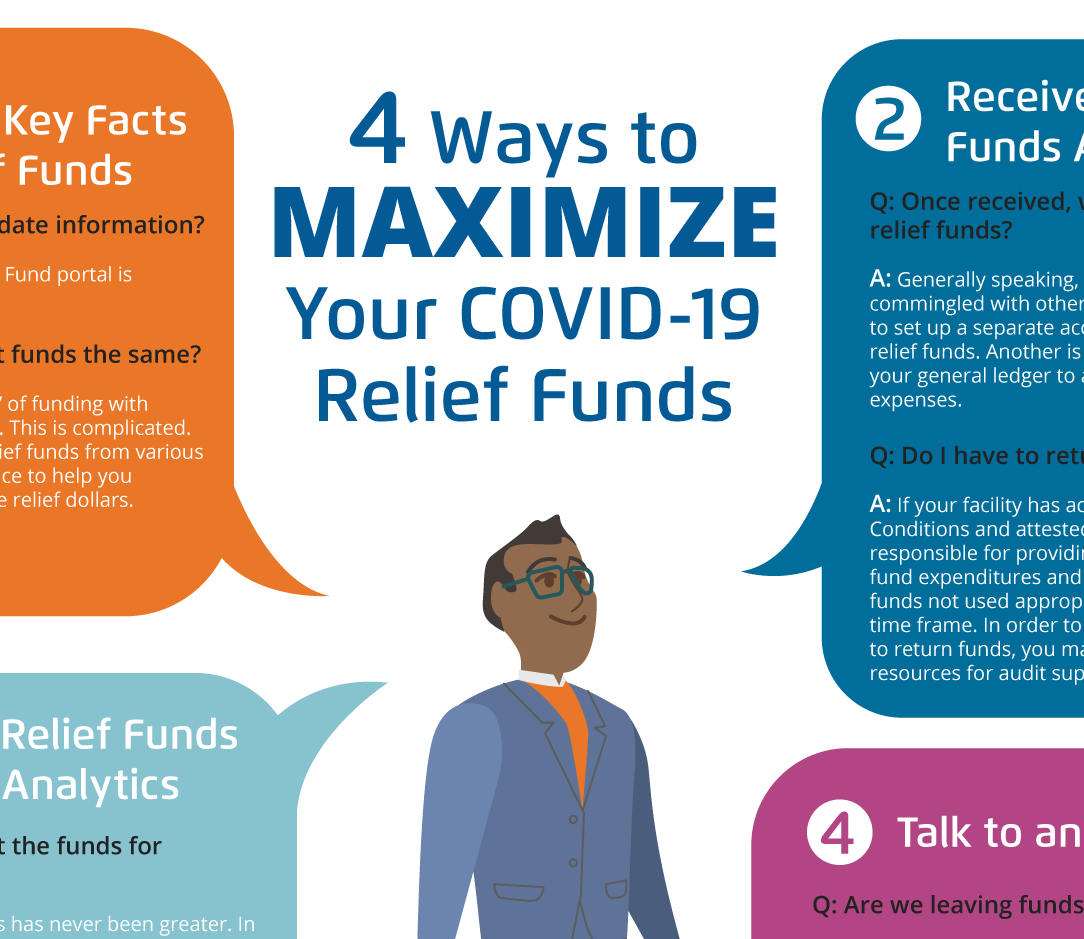While federal COVID-19 relief funding for health systems sounds good in theory, many organizations have found accessing and using these monies overwhelming and frustrating. Federal guidance has been inconsistent or incomplete, and continued changes to relief packages and policies challenge organizations to develop pragmatic financial recovery strategies. Financial leaders who are confronting more questions than answers need a simple framework to move confidently into recovery.
The following five expert financial- and healthcare-based guidelines will help organizations navigate and optimize COVID-19 relief funding:
1. Regularly review legislative and regulatory updates and agency activity.
2. Make the most of what’s available.
3. Use required reporting as a decision-making tool.
4. Prepare now for the inevitable audit.
5. Test compliance now to eliminate headaches (or litigation) later.

Many healthcare organizations have more questions than answers regarding recent guidance on COVID-19 relief funding for hospitals and health systems. The logistical and compliance realities of managing funding from the CARES Act, FEMA, the Paycheck Protection Program, and other emergency resources are often overwhelming and frustrating, as federal guidance has been inconsistent or incomplete.
The following expert financial- and healthcare-based guidelines will help organizations navigate and optimize COVID-19 relief funding.

Five solutions combine financial and healthcare industry expertise to offer a strategic, data-driven approach to help organizations maximize relief dollars and create a financially sustainable future:
Legislative and regulatory bodies and associated agencies often introduce new relief guidance, sometimes in conflict with earlier direction, and continually update past guidance. Healthcare organizations must consistently follow legislative and agency activity and regulatory updates, watch for new emergency funding sources, and continuously monitor potential sources of funding. Financial teams that don’t have the extra bandwidth to monitor healthcare relief funding updates can look to education and information resources (e.g., webinars, blogs, podcasts, and newsletters). Additionally, trusted sources (e.g., an accounting and business advisory firm such as HORNE and a healthcare domain expert like Health Catalyst) will provide more personalized, in-depth support.
Organizations optimize relief funds by first adopting best practices to capture expenses attributable to COVID-19 per regulations, government agency pronouncements, reporting requirements, and FAQs. Successful organizations must also clearly separate “healthcare-related expenses attributable to coronavirus” to apply against appropriate funding sources and employ compliant lost revenue calculations. These steps will help organizations keep more of the funds they receive and identify the greatest need and opportunity areas.
While official definitions of terms, such as “lost revenue,” and thus federal guidance, remain somewhat in flux, organizations still have the opportunity to optimize their current funding. Doing so involves regularly following legislative updates (as in guideline #1, above) and tracking all funds received and the applicable terms and conditions for each funding source at the Taxpayer Identification Number (TIN) level.
Timely filing of all required reports to the appropriate federal agency is critical in optimizing funding. However, even prepared financial teams need to look closely at the data in their reports. They must adapt accounting systems to identify, capture, and correctly document all healthcare-related expenses.
Many organizations are overlooking eligible expenditures associated with COVID-19—including prevention, preparation, or response and expenses related to maintaining healthcare delivery capacity. Regularly reviewing expenditures in careful detail will inform timely decisions about the most appropriate revenue recognition policies and maximization of stimulus funds.
The Office of Inspector General (OIG) has indicated that audits for relief funds are not a question of “if” but “when.” Contemporaneous documentation in the form of support for lost revenue and healthcare-related expenses, including receipts, calculations, and regulatory guidance at the time of decisions, is key to audit preparation. It’s in a health system’s best interest to prepare schedules to support emergency funding activity by entity and source alongside cumulative lost revenues and healthcare-related expenses.
No health system leader wants to put their facility at risk of fines, returning of funds, litigation, bad press, or closure due to error or non-compliance. However, changing rules and regulations make compliance hard to understand and challenging to follow.
To test compliance preparedness, organizations can make appropriate modifications and assess compliance programs regularly to minimize risk. They must also establish a robust set of internal controls over relief funding to ensure its appropriate use. Financial leadership should also educate and communicate with the organization’s stakeholders on legal, business, and compliance risks. Health systems that emphasize compliance early in the relief funding process will be more inclined to view relief funds through the appropriate compliance lens and make fewer errors in the long run. Strong external partners, such as HORNE and Health Catalyst, can positively impact this process.
The scope and continual evolution of all forms of COVID-19 relief funding have made the development and execution of pragmatic financial strategies daunting. And, though healthcare organizations can’t predict the next phases of funding or impending changes, they should position themselves to maximize their current relief dollars and manage compliance with this simple five-step actionable, informed approach.
Would you like to learn more about this topic? Here are some articles we suggest:
PowerPoint Slides
Would you like to use or share these concepts? Download the presentation highlighting the key main points.
Click Here to Download the Slides